We lose so much in history to the sands of time, especially those moments the gatekeepers of our collective memories want us to forget. Those moments that betray our worst tendencies as a country, smear our image, and reveal hard truths about our roots. Mixed-media artist Nekisha Durrett has dedicated much of her art practice to unearthing such marginalized histories, with her latest sculpture in West Palm Beach shedding light on the rich history of The Styx.
“The Styx were a community of Black people who migrated to Palm Beach island to build what is considered to be the birthplace of American hospitality,” Durrett explained. “It’s a rich yet tragic and familiar history. One in which Black people are used for labor and when that labor is no longer needed, and the land on which they inhabit is deemed valuable, they are removed from their land by violence or eminent domain— in this case, by fire.”

As part of ArtLife West Palm Beach, Durrett constructed a large-scale, site-specific sculpture in Heart & Soul Park in West Palm Beach entitled Genius Loci. Meaning “spirit of a place,” Genius Loci depicts the form of an RCA gramophone made from copper sheeting supported by concrete that resembles charred wood. It’s inspired by the former Sunset Lounge, a famed jazz club dubbed “Cotton Club of the South,” and the overlooked history of The Styx.
The public commemoration for Genius Loci took place December 1, 2023, kicking off West Palm Beach’s New Wave Art Weekend with an artist talk and marching band celebration. To continue honoring Durrett’s stunning tribute to The Styx, I reached out with a few questions about the project. Her responses are below.

Why did you decide on a gramophone for this sculpture? What about a gramophone is so symbolically rich and visually compelling?
In doing research, I looked to early photographs of happenings at the Sunset Lounge, a historic jazz lounge established by the residents of the Northwest community in the 1940s. I read accounts of people who attended performances there. As part of the so-called “Chitlin Circuit,” all the greats of the time performed there— Ella Fitzgerald, Count Basie, Louis Armstrong, Duke Ellington, and so on. In a remark that fills me with inspiration, Duke Ellington once spoke about the inspiration behind one of his songs called “Airshaft.” He describes the air shaft of a Harlem tenement as a “loudspeaker” because, when you put your ear up to it, you could hear couples fighting or making love or even smell what people were cooking for dinner. I loved this visual of the air shaft as a speaker amplifying the euphony of Black joy and sorrow out into the world.
I found images that showed the progression of speakers and amplifiers from the 1940s to the present day, and I designed a mashup of an RCA gramophone’s flowerlike form and the tweeter of a modern-day speaker and went from there. For me, the placement within the park suggests that the voices of the past are being amplified up from the ground and out toward the viewer and beyond. Many people have asked if there is a sound component. The answer is no, but I believe if one is paying a certain kind of attention, a vibration can be felt. Copper is a powerful conductor, after all.

By that same token, why copper? What was the thought process behind that material for this project in particular?
The people of The Styx who built Palm Beach in the late 19th century were artisans, highly skilled, pride-filled people who used these skills and the love of their trades to build exquisite and marvelous structures with the highest quality materials— the Florida East Coast Railroad from Florida to West Palm Beach and two opulent hotels, The Breakers and the Royal Poinciana. These were spaces that they would never be able to enjoy for themselves. Additionally, there are accounts that, despite the wealth of oil tycoon Henry Flagler, who bankrolled these projects, these artisans and hotel workers were paid little and not on time. When those migrants initially moved to the island, they were tasked with building their own homes. These modest, shanty-like homes were built with what they had access to— scraps from the structures they toiled to build with hardly any pay.
I wondered what they would build for themselves if they had access to the finest building materials and space to dream? I’ve always been drawn toward the beauty of copper roofing and cladding and imagined that gramophone speaker decked out in copper. Something that came to me later, after Genius Loci was well into production, was the healing properties of copper and its capacity to conduct electricity and produce power. I was hiking in the mountains of Virginia when a group of Black hikers decked out in copper jewelry and copper walking sticks got me out of a literal tight spot— I had wedged myself into a tight opening between two large rocks. They encouraged me to find my way out by shouting down from the top of the opening that I was following in my ancestors’ footsteps and to let the power of my mind, body, and breath lead me out. I was so moved by the experience that I researched copper when I got home. I always envisioned this piece as a site for healing, so this discovery seemed apropos.
Another thing about copper is how it changes over time. Patinated copper is so beautiful. Weathering from the elements only makes the material richer. It’s also important to note that the plinth for the sculpture is made to resemble charred wood, a detail that echoes the appearance of the former Styx community after their homes were burned to the ground by white folks who wanted them gone.
What do you hope viewers of Genius Loci feel or think about when experiencing it?

I can share a couple of encounters I experienced during the week of the installation of Genius Loci in the park. A gentleman approached me and asked what the sculpture was, and we talked for a while. He shared with me that his leg had been injured, and it seemed that he had been on a long physical and spiritual healing journey. He said that to heal his leg, he began removing his shoes and socks so that his bare feet could have direct contact with the earth. I asked him if he knew that the sculpture was made of copper. He did not, but a smile grew on his face when he learned this and asked if he could touch it. I told him that, of course, he could, and he climbed into the sculpture pad and laid both hands on the surface for several seconds. I asked if he felt it, and he said, “Yeah! I got chills!”
Later in the evening, a young man named Zamari strolled up to me and the crew. I don’t think I’ll ever forget his name. He had the same question, “What is this?” We talked and then stepped into the sculpture pad together. I wanted him to see himself in the reflection of the mirror polished, coppertone tweeter. On instinct, he pulled a lighter from his pocket and lit it between the two of us with the night sky reflected behind us. I turned to him and told him, this is yours now. He said, “Mine?” I said, “Yep.” And he goes, “Wow.”
Genius Loci is an abstraction of the complex history distilled into this rather simple form. It is the spirit of that place. The work is not didactic; it’s not literal, but in that moment, Zamari made a flame between the two of us, and we shared in its glow. The flame that destroyed his ancestors’ home now conjoined us two strangers. How powerful is that?
I heard something recently— “If you don’t shape your heart, the world will shape it for you.” The people of The Styx did not let the sentiments of outsiders nor their fire destroy them or shape their hearts. They took that experience and their will, and their genius lit a flame, shaping their hearts in the form of a beautiful community, a network of care and love still standing.

Charlotte Beach
Charlotte is a New England expat currently living in Los Angeles, CA with her cat, Joan Cusack. She is a power-clashing maximalist with an inordinate disdain for the color navy. When she’s not writing about ad campaigns and colorways you can find her scouring estate sales or attempting to teach herself calligraphy.











